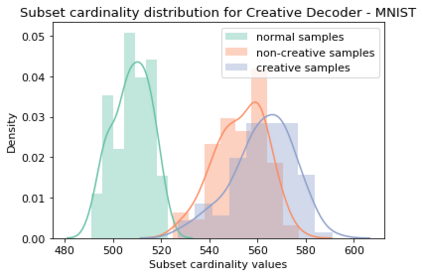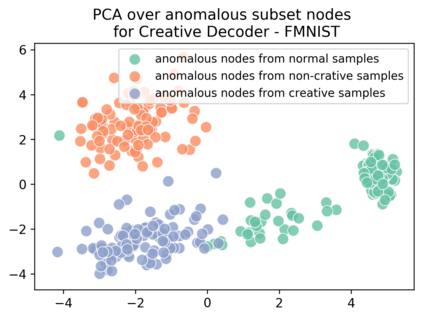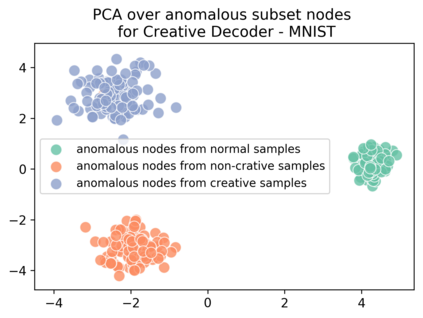Deep generative models, such as Variational Autoencoders (VAEs), have been employed widely in computational creativity research. However, such models discourage out-of-distribution generation to avoid spurious sample generation, limiting their creativity. Thus, incorporating research on human creativity into generative deep learning techniques presents an opportunity to make their outputs more compelling and human-like. As we see the emergence of generative models directed to creativity research, a need for machine learning-based surrogate metrics to characterize creative output from these models is imperative. We propose group-based subset scanning to quantify, detect, and characterize creative processes by detecting a subset of anomalous node-activations in the hidden layers of generative models. Our experiments on original, typically decoded, and "creatively decoded" (Das et al 2020) image datasets reveal that the proposed subset scores distribution is more useful for detecting creative processes in the activation space rather than the pixel space. Further, we found that creative samples generate larger subsets of anomalies than normal or non-creative samples across datasets. The node activations highlighted during the creative decoding process are different from those responsible for normal sample generation.
翻译:在计算创造性研究中广泛采用深基因模型,如变异自闭式自动读数模型(VAEs),这种模型在计算创造力研究中广泛采用深基因模型,然而,这种模型抑制了分配外的生成,以避免虚假的样本生成,从而限制其创造力。因此,将人类创造力研究纳入基因外深层学习技术,提供了一个使其产出更具有说服力和人性相似的机会。随着我们看到针对创造性研究的基因化模型的出现,有必要采用基于机器学习的代孕指标来描述这些模型的创造性产出。我们提议以集团为基础的子扫描来量化、检测和定性创造性过程,方法是通过探测隐藏的基因模型层中的异常点点点作用子。我们在原始的、典型的解码和“创造性解码”(Das等人,2020年)图像数据集的实验表明,拟议的子分数分布对于探测空间的创造性创造过程比像素空间的创造性输出过程更有用。此外,我们发现,创造性样本产生的异常子组比正常或非遗传样本在数据集中产生更多的异常分数,这些正常的样本在生成过程中被强调。










